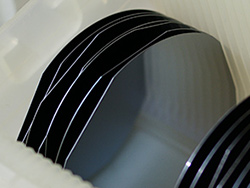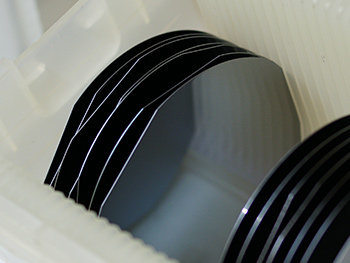Making microchips at home - steps 0 and 1
 In this article, I will talk about the beginning of my work on a completely crazy task: the ultimate goal is to get a working microcircuit according to the "thick" standards (5-10µm) at home. This is not the first of April and I'm not crazy, it's just my hobby.
In this article, I will talk about the beginning of my work on a completely crazy task: the ultimate goal is to get a working microcircuit according to the "thick" standards (5-10µm) at home. This is not the first of April and I'm not crazy, it's just my hobby. This idea arose not now and for good reason. Since childhood, I wanted to be a gas welder, and ... make chips. And if, according to the first point, I managed to quickly make a welding machine at home (butane-hydrogen / oxygen), then everything could not add up to the microcircuits. For a long time, all thoughts rested on the fact that I did not know where to get the semiconductors of the necessary purity proper (and my thoughts stopped on picking powerful transistors), until the forum suggested that, in principle, it is possible to buy wafers. Then I even stumbled upon a man who20 years working on a similar task , and eventually gave up. Perhaps it was possible to give up and stop wasting time on stupid dreams. But, once I saw a video of a monstrously brilliant woman - Jeri Ellsworth - she was able to make separate field effect transistors based on factory plates - and then I decided that it was time to tackle this problem more closely.
In this article I will talk about my current progress, but do not expect a quick continuation - the whole process can easily take a couple of years.
Step 0:
All books on the topic were bought from local online stores (just 1 shelf), all available collections of digitized books were downloaded from torrents. Of course, there is a lot of theoretical information there, but on the practical side, much is obscured. Even the old technical processes are not described in detail anywhere, and therefore you will have to try a lot. He also rummaged through the Internet in search of local suppliers of all potentially necessary materials (silicon itself, photoresists, chemistry, gases). So far, it has not been possible to find a local company that can manufacture aspherical optics from optical / quartz glass - but this will not become an obstacle in the coming year.
Step 1: Silicon
 Monocrystalline silicon is the heart of a home chip. Growing up at home is real (by my crazy standards), but damn expensive. Therefore, I began to google local silicon producers - someone said that they stopped production and only rented out premises, someone did not answer until finally I got to Terasil company - there I was finally able to buy everything I needed. The most important thing is the cut and polished wafers of monocrystalline silicon doped in P and N type (right in the photo).
Monocrystalline silicon is the heart of a home chip. Growing up at home is real (by my crazy standards), but damn expensive. Therefore, I began to google local silicon producers - someone said that they stopped production and only rented out premises, someone did not answer until finally I got to Terasil company - there I was finally able to buy everything I needed. The most important thing is the cut and polished wafers of monocrystalline silicon doped in P and N type (right in the photo). Next up is a bunch of broken plates for training. I trained to split the plate into pieces (it turned out that they are all with the orientation of the crystal lattice 111 - they are broken by triangles, not squares). Because they have not been polished yet - I tried and polished - the failure is complete: the goy paste does not take silicon, we need a diamond paste. If, over time, it turns out to be polished, it will be possible to try to make solar batteries (and from monocrystalline silicon they are quite effective).
Next up is a bunch of broken plates for training. I trained to split the plate into pieces (it turned out that they are all with the orientation of the crystal lattice 111 - they are broken by triangles, not squares). Because they have not been polished yet - I tried and polished - the failure is complete: the goy paste does not take silicon, we need a diamond paste. If, over time, it turns out to be polished, it will be possible to try to make solar batteries (and from monocrystalline silicon they are quite effective). And finally - pieces of single-crystal silicon. Those that are thick on the left are dirtier (but clean enough for microcircuits), 2 thin on the right are ultra-clean, much higher than silicon purity requirements for conventional microcircuits. Of course, cutting them out at home will not work (unless of course the diamond circular saw is littered) - just smash it. They are needed to try to precipitate amorphous silicon films chemically (PE CVD SiH4) or physically (vacuum evaporation).
And finally - pieces of single-crystal silicon. Those that are thick on the left are dirtier (but clean enough for microcircuits), 2 thin on the right are ultra-clean, much higher than silicon purity requirements for conventional microcircuits. Of course, cutting them out at home will not work (unless of course the diamond circular saw is littered) - just smash it. They are needed to try to precipitate amorphous silicon films chemically (PE CVD SiH4) or physically (vacuum evaporation).What are the next challenges
- First of all - the construction of a furnace at 1200 degrees for a small sample. Industrial furnaces cannot be placed at this temperature in the apartment, and they cost a lot. Therefore I will try to heat the sample with halogen lamps with reflectors.
- Moving to a separate apartment: I was immediately kicked out when I saw a bearded man in a gas mask and rubber gloves with a bunch of suspicious jars.
- Next - the necessary chemistry and photoresists - and you can try to make 1 transistor according to the Jeri process.
What I'm looking for and can't find yet
First of all, this is information. I would like to have contacts of people who work in production - because I will collect all the rakes that technologists have been collecting for the last 50 years.
Comments / opinions - in the studio.
